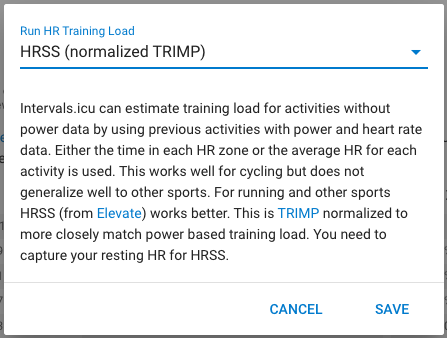For me Elevate is the same / really close to training peaks when calculating heart rate based load.
I found this post. I don’t have HR rest so I will need to guess that and see what difference it makes + add a field to capture it.
Consider also rTSS. However, it requires to take into account the terrain using the non-graded pace (as in TrainingPeaks) or grade-adjusted pace (as in Strava).
I will get on this next week. Away for the weekend so won’t get to play on my laptop much.
Anyone know if Elevate invented HRSS or if it comes from a paper somewhere? I haven’t been able to find out and I want to give proper credit.
The idea on HRSS in Elevate is related to Trimp100 in GoldenCheetah. Thus, TRIMP normalized to the 100 per hour stress score scale that is used for TSS. The discussion on what to use as a base for the normalization stemmed from a mailing list discussion. Especially if you don’t know your threshold HR from testing.
e: Here is the discussion on github: https://github.com/thomaschampagne/elevate/issues/341
Tx a stack. That is very helpful.
Wow. In my initial testing HRSS gets results very close to TSS from power. I have looked at a few activities and its within a point or two. I have a good number for LTHR. If that is off it won’t be as good. I should be able to get this live on Thurs.
Screenshot of the configuration in /settings (not live yet!). Separate model selection for bike and run (used for everything non-cycling).
![]()

HRSS support is live now and is the default for non-cycling activities. For cycling the default is still “time in HR zones” with fallback to HRSS if there isn’t enough data or the model is poor. The “time in HR zones” model gives better results (for me, for cycling) than HRSS.
I am going to deploy code tonight to fix up everyones data. Right now if you have an iffy activity you want to fix, click “Reset” under the ride timeline chart.
Great! Is there anyway to bulk reset actvities? I have around 6 months of activities where I need to fix this 
That should have already happened?
It has happend now :).
Only tried your “time in zones” method once, but it seemed very accurate.
I took my gravel race rig out for a first shake out ride with no PM and Strava power estimate was nowhere close to RPE given that I was on muddy 15%+ climbs and lots of headwind on the road.
I was pleasantly surprised when I saw the TSS estimate. May put off purchasing a PM. Was fun to just ride and not look at numbers for a change, but still have the load estimate to keep things on track.
This one is 130 now and the marathon is 216.
Much better! Thanks  I’ll keep you posted if I notice something off
I’ll keep you posted if I notice something off
David.
Post the Push this has reduced the TSS for all non-cycling activites significantly. However, this still mucks up the ‘Time In Zone’ calculation for those with a broad body of non-cycling workouts (everything is base because time in zone is not weighted by stress e.t.c). Is there still a plan to allow us to only count cardio activities towards cardio stress calculation and times in zone?
Yes there is. I hope to get on that soon. Planning to have a fitness factor and fatigue factor for each activity type so you can make strength work in the gym count towards fatigue but not fitness and so on. I hadn’t thought about leaving some of the out of “time in zones” but that make sense.
I could do that if the fitness factor is zero … if its not improving fitness makes sense to ignore the HR data for “time in zones”.
Aye - the reality is that whilst weightlifting (ignoring here Metcon or crossfit-style cardio workouts) causes heart rate rises, this is due to thoracic pressure rather than aerobic fitness pressure.
It’s hard to quantify any exercise that isn’t cardiovascular in nature using heart rate data. I’ve heard of including lifting etc in CTL - but the problem with this is that it impacts upon your form (aka your tiredness and capacity to conduct workouts). Whilst lifting will impact your muscular ability to complete workouts, it will have little to no bearing on how well prepared your cardiovascular system is for conducting difficult workouts, races e.t.c.
Probably best to allow all variable sport types to be given a custom factor but my default would be only cycling, runnning, crosstraining, ski touring, xc skiing e.t.c.
I have started implementing fitness and fatigue factors for each of the activity types supported by Strava (and fitness factor of 0.0 means leave out of time in zones as well). This will be configurable per athlete but I would like to have good default list. Note that this only apply to activities with training load derived from heart rate data.
I have all of these at fitness 1.0 and fatigue 1.0 i.e. full training load counts:
Ride, Run, Swim, Hike, Walk, AlpineSki, BackcountrySki Canoeing Crossfit, EBikeRide, Elliptical, Handcycle, IceSkate, InlineSkate, Kayaking, Kitesurf, NordicSki, RockClimbing, RollerSki, Rowing, Snowboard, Snowshoe, StairStepper, Surfing, Velomobile, VirtualRide, VirtualRun, Wheelchair, Windsurf
These only add to fatigue:
WeightTraining fitness 0.0 fatigue 1.0
Workout fitness 0.0 fatigue 1.0
These don’t add to fitness or fatigue:
StandUpPaddling fitness 0.0 fatigue 0.0
Yoga fitness 0.0 fatigue 0.0
Any suggestions or changes?